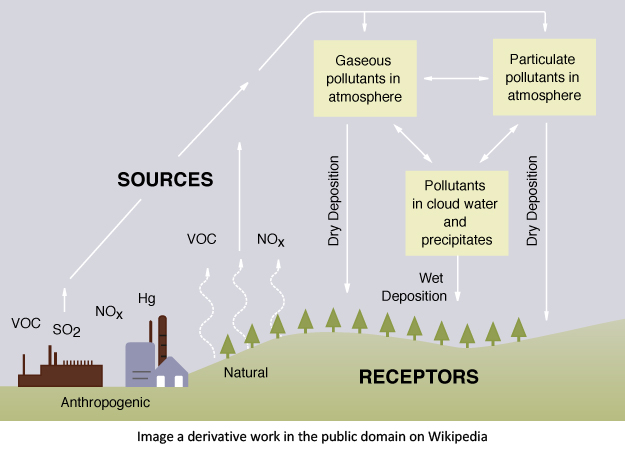But the issue seems to have disappeared since that time. Is the reason for this that we actually solved a pressing environmental problem, or did acid rain simply get pushed down the priority list as new, more urgent environmental issues came to the forefront?
What is Acid Rain?
Acid rain is rain or any other type of precipitation, including snow or fog, that is unusually acidic. Acid rain is caused by sulfur dioxide, or nitrogen dioxide emissions released into the air and react with water molecules before falling to the ground as rain or snow. Most sulfur or nitrogen dioxide comes from electrical power plants, with a smaller amount coming from cars and other vehicles and natural sources such as volcanoes and wildfires. Both emissions, move by circulating air and wind, can travel long distances so that acid rain may be found in areas far from its source.
Acid rain can create highly acidic soils, adversely affecting the growth of forests and crops. Acidic waters can result in the death of fish and other aquatic species. Acid rain also enhances the deposition of mercury, which has adverse effects on human health. Direct impacts on human health have also been documented. A severe episode of acid fog, the Great London Smog of 1952, resulted in an increase in the daily average death rate from 252 to approximately 1,000, and acid fog was responsible for several severe air pollution episodes in southern California in the 1980s.
History
- 1852 - Scientists identified a relationship between acid rain and air pollution in Manchester, England.
- 1972 - Scientists discovered rain deposited in the White Mountains in New Hampshire was acidic.
- 1980 - Congress passed the Acid Deposition Act establishing an 18-year assessment and research program on acid rain.
- 1983 - National Academy of Sciences (NAS) issues a draft report saying that acid rain is a real problem that needs to be addressed.
- 1990 - Congress passed a series of amendments to the Clean Air Act establishing a cap-and-trade system designed to control sulfur dioxide emissions. A more traditional regulatory program was established to control nitrogen dioxide emissions.
What is cap-and-trade?
“We devised a cap-and-trade approach, written into the 1990 Clean Air Act. It required cutting overall sulfur emissions in half, but let each company decide how to make the cuts. Power plants that lowered their pollution more than required could sell those extra allowances to other plants. A new commodities market was born.”
Cap-and-trade is a market-based solution to environmental concerns developed with all stakeholders, the regulators, environmental advocates, and businesses.
- EPA sets a cap, or a limit, on the total amount of sulfur dioxide allowed to be emitted by all electric-generating power plants in the U.S.
- Allowances are “authorizations to emit” allocated to every power plant.
- An allowance market was set up that allows power plants and others to buy or sell allowances throughout the year.
- Power plants are given the flexibility to choose their own options to reduce emissions, such as adding emission controls, using more advanced technologies, switching to new fuels, using banked allowances, or buying allowances from the market.
- At the end of every compliance period, each power plant must have enough allowances to cover their sulfur dioxide emissions, or the EPA fines them.
This system gives businesses strong financial incentives to cut emissions. Electrical power plants emitted 778 thousand tons of sulfur dioxide in 2020, well below the permanent cap of 8.95 million tons.
What Happened?
A 93% reduction in annual sulfur dioxide emissions between 1990 and 2019!
 Most of the decrease was due to greater use of control technology in coal-fired plants and increased use of natural-gas-fired plants that emit very little sulfur dioxide. [1]
Most of the decrease was due to greater use of control technology in coal-fired plants and increased use of natural-gas-fired plants that emit very little sulfur dioxide. [1]
There was also an 87% reduction in annual nitrogen dioxide emissions between 1990 and 2019.
Significant decreases occurred in acid rain nationwide – wet sulfate deposition, an indicator of acid rain, decreased by 68% between 1989 and 2019.
Why Such Little Attention?
The acid rain issue has been called “the greatest green success story of the past decade” by The Economist in their article “The Invisible Green Hand.” Two factors may explain why we heard so much about acid rains' harmful effects and so little about our successful mitigation. First, economic solutions often become baked in, integrated into our economy, creating an invisible fix not apparent to most people. Second, journalists just don’t like to cover good news stores – it doesn’t gather our attention and emotional responses the way bad news does.
Conclusions
The acid rain story should be studied by every person interested in environmental policy. The cap-and-trade approach is currently being used to help solve climate change in the U.S. and globally. For example, California instituted a cap-and-trade policy for carbon emissions, leading to a steady decline in carbon dioxide emissions. The European Union capped carbon dioxide emissions from some industrial sources, which led to a 29% reduction from 2005 to 2018. China, the world’s largest emitter of greenhouse gases, began a carbon cap-and-trade program in 2017.
On a broader level, acid rain should give us hope for the future that the government, private sector, and non-profits, working with technological solutions, can solve today’s pressing problems. Acid rain was an issue that seemed unsolvable 40 years ago, but today is held up as an example as to what is achievable.
[1] The EPA’s website, from which the graphic was taken, has several interactive charts showing the significant improvement in our air over the last 30 years.
Sources: Environmental Defense Fund. How Cap and Trade Works , How Economics solved acid rain
U.S. Environmental Protection Agency: Acid Rain Program, Acid Rain Program Results





